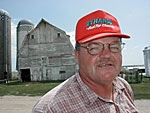By Mark Steil
Minnesota Public Radio
August 2, 2002
Most of Minnesota has had plenty of rain this summer, some areas have had way too much. But the southwest corner of the state is dry. Some areas are as much as five inches below normal rainfall for the year and that's hurting crops.
| |
|
|
|
||
Dark clouds fill the northern sky as farmer Spencer Sells pilots his pickup truck down a tiny lane through his cornfield. It's so narrow that the leaves of the cornstalks slap the truck:
"Looks like we got a chance of maybe some moisture today," Sells says. "The last couple weeks we've had rain in the forecast almost every other day it seems like but we not can't get any."
Sells has watched storm after storm approach his Rock County farm, only to veer away."It's been like everything that goes either goes north of here or goes south of here; it seems like we're getting cheated here a little bit," he says.
A strip of counties along the Iowa border are as much as five inches below normal rainfall for the year. The signs of drought are everywhere. Brown pastures. Low water in streams and marshes. Curled corn leaves.
Sells gets out of his truck to examine the the developing ears. The first is normal size, but a few stalks down a second ear shows the impact of the dry weather. "It looks like it's about half the size of the other one, but it looks like it was pollinated here and has potential to develop, maybe half an ear. But you can see here the curling in here. It's trying to conserve moisture. It's not good," Sells says.
|
"Severe drought is encompassing almost 38 to 40 per cent of the country; levels we haven't seen since the '50s. "
- Mark Svoboda, National Drought Mitigation Center |
Sells' farm in southwest Minnesota near the town of Beaver Creek is on the eastern edge of a drought area stretching west to the Pacific Ocean. Mark Svoboda with the National Drought Mitigation Center in Nebraska says the dry patch is expanding.
"This drought is really over the last... six to eight weeks, pushed out of the Rocky Mountain states out onto the Plains states. And really since Memorial Day is when conditions have really kind of deteriorated," Svoboda.
A second drought area is centered in the southeast U.S. Adding it all up, Svoboda says its an historic dry spell. "We have 39 states defined in some sort of a drought. Severe drought is encompassing almost 38 to 40 per cent of the country. Levels we haven't seen since the '50s."
The dry weather has already caused huge losses. Western wild fires have been the most visible, but there are others. Ranchers in North and South Dakota are selling cattle because of a shortage of feed. Crops in some parts of Nebraska and Kansas crops are a total loss. In southwest
Minnesota extension official Fraser Norton says each rainless day cuts into the coming harvest. "The fact that we haven't had rain over the past two weeks and it doesn't look very good over the next couple of weeks, that's what's really, really hurting us now. And there's no question we've had yield losses. In the corn I would say in many, many fields a third is, you know up to 30 percent loss already," according to Norton.
| |
|
|
|
||
Grain prices have been rising because it looks like the drought will significantly reduce U.S. crop yields compared to recent years. But those higher prices won't help farmers like Spencer Sells because drought is reducing the amount of grain they'll have to market. Sells watches the clouds to the north as a midday sun heats things up.
"I think it's in the mid to upper 90's. Pretty humid, but not much breeze, so it probably feels hotter. I know at noon they were talking a 90-degree heat index already so I'm sure maybe we'll get to 100 today," he says.
That night thunderstorms hopscotch across southern Minnesota. The next day Sells report that he too got rain. "Just enough to get the sidewalk wet. I heard somebody say they had .02, but ours was less than .01."
Sells say what he really need is an all-day soaker, but that's not in the forecast anytime soon.
More Information

